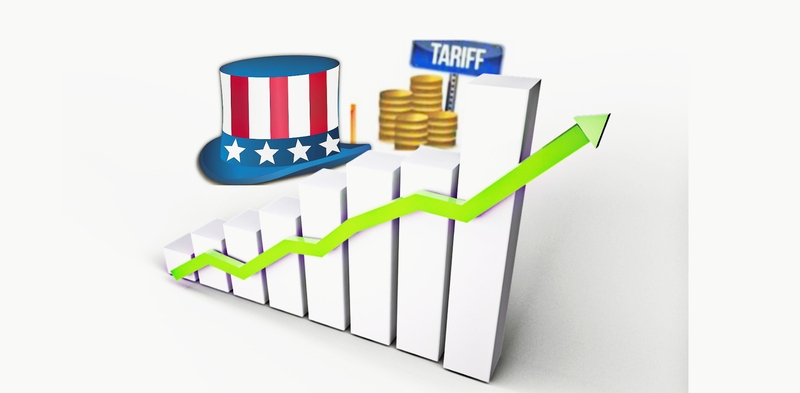 A concept of Tariffs by the US and their potential on the economy. Photo Credits: Pixabay
A concept of Tariffs by the US and their potential on the economy. Photo Credits: Pixabay
U.S Tariffs Shake Global Trade: Retaliatory Tariffs By China, European Union And Global Market Uncertainty
NorthAmerica
Business
In a sweeping shift that has sent tremors through global markets and reignited geopolitical tensions, the United States has rolled out a series of aggressive tariffs on imported goods. Marking one of the most significant reversals of free trade policy in decades, the move has disrupted diplomatic relations and raised questions about the future of globalization, international trade governance, and the U.S.'s role in the global economy.
The White House’s Justification: Correcting Trade Imbalances
The White House views the tariffs as part of a broader effort to correct chronic trade imbalances and revive manufacturing jobs lost to decades of outsourcing. Officials argue that past trade deals have disproportionately favored foreign producers at the expense of American industry, asserting that the U.S. can no longer afford to subsidize and support other economies while hollowing out its own.
Critics Warn of Political Motives and Economic Risks
However, critics contend that the tariffs are politically motivated, designed to energize domestic constituencies ahead of the 2026 midterm elections. While short-term gains may seem favorable, long-term risks—including higher prices, supply chain disruptions, and retaliatory tariffs—could weigh heavily on the U.S. economy.
Global Retaliation: China and the EU Respond
China's Swift Countermeasures
The White House’s Justification: Correcting Trade Imbalances
The White House views the tariffs as part of a broader effort to correct chronic trade imbalances and revive manufacturing jobs lost to decades of outsourcing. Officials argue that past trade deals have disproportionately favored foreign producers at the expense of American industry, asserting that the U.S. can no longer afford to subsidize and support other economies while hollowing out its own.
Critics Warn of Political Motives and Economic Risks
However, critics contend that the tariffs are politically motivated, designed to energize domestic constituencies ahead of the 2026 midterm elections. While short-term gains may seem favorable, long-term risks—including higher prices, supply chain disruptions, and retaliatory tariffs—could weigh heavily on the U.S. economy.
Global Retaliation: China and the EU Respond
China's Swift Countermeasures
China, which exported over $500 billion worth of goods to the U.S. in 2024, retaliated quickly by announcing a 34% blanket tariff on all American imports, effective April 10. Beijing has also threatened to restrict exports of rare earth minerals—critical to U.S. defense, electronics, and energy sectors—and has filed a formal complaint with the World Trade Organization (WTO), accusing the U.S. of violating key trade agreements.
The European Union’s Response
The European Union’s Response
Meanwhile, the European Union is preparing its own countermeasures. European Commission President Ursula condemned the U.S. tariffs as economically shortsighted and politically regressive. The EU is drafting a list of retaliatory tariffs targeting U.S. agricultural goods, aircraft parts, and tech products, with potential impacts exceeding £26 billion.
In a sign of growing diplomatic realignment, China and the EU are reportedly exploring new trade mechanisms to bypass U.S. dominance, signaling a potential redrawing of global trade alliances.
Financial Markets in Turmoil
The financial markets have reacted with notable volatility. Wall Street experienced a $2.5 trillion wipeout within days of the tariff announcement, with the S&P 500 and Nasdaq posting their sharpest single-day drops since 2020. This volatility could signal the beginning of a broader market correction, particularly for sectors reliant on imports and global supply chains, such as technology, retail, and auto manufacturing.
Rising Consumer Prices and Industry Fallout
At the consumer level, prices are expected to rise significantly. Retailers have already warned of impending markups on a wide range of goods, from electronics to household essentials. U.S. farmers, heavily reliant on exports to China and Europe, are bracing for losses as foreign markets impose restrictions on American soybeans, pork, and corn.
Stagflation Fears Loom
The tariffs have also sparked fears of stagflation—a dangerous combination of rising inflation and slowing economic growth. With interest rates still elevated to combat previous inflationary pressures, the Federal Reserve now faces a precarious balancing act in managing monetary policy.
A New Geopolitical Reality
Beyond economics, the tariffs represent a deeper geopolitical shift. As the U.S. seeks to decouple from global supply chains and assert trade independence, other nations are reevaluating their reliance on American markets. The emerging trend points toward the formation of economic blocs—one led by China and the other by the U.S.—each backed by regional partners and new trade agreements.
This fracturing of global trade dynamics risks reducing economic efficiency, fueling inflation, and escalating economic conflicts into broader political disputes.
The WTO’s Diminished Role
The World Trade Organization now faces a crisis of relevance, as major powers increasingly bypass or challenge its authority. While some analysts argue that the U.S. could be using tariffs as leverage to renegotiate better trade deals, ongoing retaliation could plunge the global economy into a prolonged slowdown.
A Fractured Future for Global Trade
As the dust settles, one thing is clear: global trade is entering a more fractured and contentious era. Protectionism is no longer a fringe policy but a mainstream approach in several of the world's largest economies. Whether this shift results in resilience or regression will depend on how governments and businesses navigate the complex challenges ahead.
In a sign of growing diplomatic realignment, China and the EU are reportedly exploring new trade mechanisms to bypass U.S. dominance, signaling a potential redrawing of global trade alliances.
Financial Markets in Turmoil
The financial markets have reacted with notable volatility. Wall Street experienced a $2.5 trillion wipeout within days of the tariff announcement, with the S&P 500 and Nasdaq posting their sharpest single-day drops since 2020. This volatility could signal the beginning of a broader market correction, particularly for sectors reliant on imports and global supply chains, such as technology, retail, and auto manufacturing.
Rising Consumer Prices and Industry Fallout
At the consumer level, prices are expected to rise significantly. Retailers have already warned of impending markups on a wide range of goods, from electronics to household essentials. U.S. farmers, heavily reliant on exports to China and Europe, are bracing for losses as foreign markets impose restrictions on American soybeans, pork, and corn.
Stagflation Fears Loom
The tariffs have also sparked fears of stagflation—a dangerous combination of rising inflation and slowing economic growth. With interest rates still elevated to combat previous inflationary pressures, the Federal Reserve now faces a precarious balancing act in managing monetary policy.
A New Geopolitical Reality
Beyond economics, the tariffs represent a deeper geopolitical shift. As the U.S. seeks to decouple from global supply chains and assert trade independence, other nations are reevaluating their reliance on American markets. The emerging trend points toward the formation of economic blocs—one led by China and the other by the U.S.—each backed by regional partners and new trade agreements.
This fracturing of global trade dynamics risks reducing economic efficiency, fueling inflation, and escalating economic conflicts into broader political disputes.
The WTO’s Diminished Role
The World Trade Organization now faces a crisis of relevance, as major powers increasingly bypass or challenge its authority. While some analysts argue that the U.S. could be using tariffs as leverage to renegotiate better trade deals, ongoing retaliation could plunge the global economy into a prolonged slowdown.
A Fractured Future for Global Trade
As the dust settles, one thing is clear: global trade is entering a more fractured and contentious era. Protectionism is no longer a fringe policy but a mainstream approach in several of the world's largest economies. Whether this shift results in resilience or regression will depend on how governments and businesses navigate the complex challenges ahead.
Senior Editor & Author: Kenneth Njoroge
Financial Expert/Bsc. Commerce/CPA

